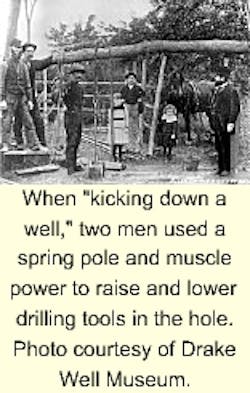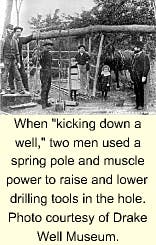Connections
A US Public Television series not long ago showed how small discoveries or insignificant events from history have led to current achievements and inventions. The program was entitled "Connections."
In each segment, it was fascinating to watch step by step how one invention would lead to another. Quite often what was developed for one use became the breakthrough technology for entire new fields. An example would be the invention of glass leading to glass bottles and eventually to the Hubbell space telescope.
The petroleum industry is a bit like that. It didn't just begin with Ed Drake punching a hole in the ground in 1859 and discovering a strange gooey substance. The history of oil use goes far back into antiquity.
Whale oil substitute
In the 18th and 19th centuries, most indoor lighting came from candles and expensive whale oil. And because more books were being written and printed (due in part to more printing presses being manufactured because a cheaper paper process had been developed), there was an increasing demand for good reading light.
A druggist named Samuel Kier operated brine wells in Pennsylvania in the 1830s and '40s but was getting oil as an unwanted by-product. He found it would burn in lamps as a substitute for expensive whale oil, but it was smelly and smoky.
Col. A.C. Ferris of New York saw the stuff and improved its burning qualities by putting it through a coal-oil refining process he was using, which had been invented by either a Canadian named Abraham Gesner or a Scot named James Young. Ferris's product was pretty good, but there wasn't much of this oil around. He began paying $20/bbl for it.
Ferris bought skimmed oil where he could get it, and also crude oil from a man named Williams in Ontario, who had drilled for it in 1856.
Progress
Drake and a group of businessmen formed the Pennsylvania Rock Oil Co. in 1854 and leased oil springs near Titus, Pa. They tried for 3 years to skim oil but went broke.
Desperate to cash in on $20/bbl oil, the company reorganized as Seneca Oil Co. Drake bought some salt-well drilling equipment and hired a crew. Drilling through 30 ft of rock, and at a depth of 691/2 ft, they hit oil. It was Aug. 27, 1859.
At the Journal, we record these events and let you know each week how the new links at the other end of the chain are being forged.
There's a long distance between the 1800s method of making hole by "kicking down" a well and the control system shown on p. 38 in our special report on coiled tubing, but there's a definite connection.

